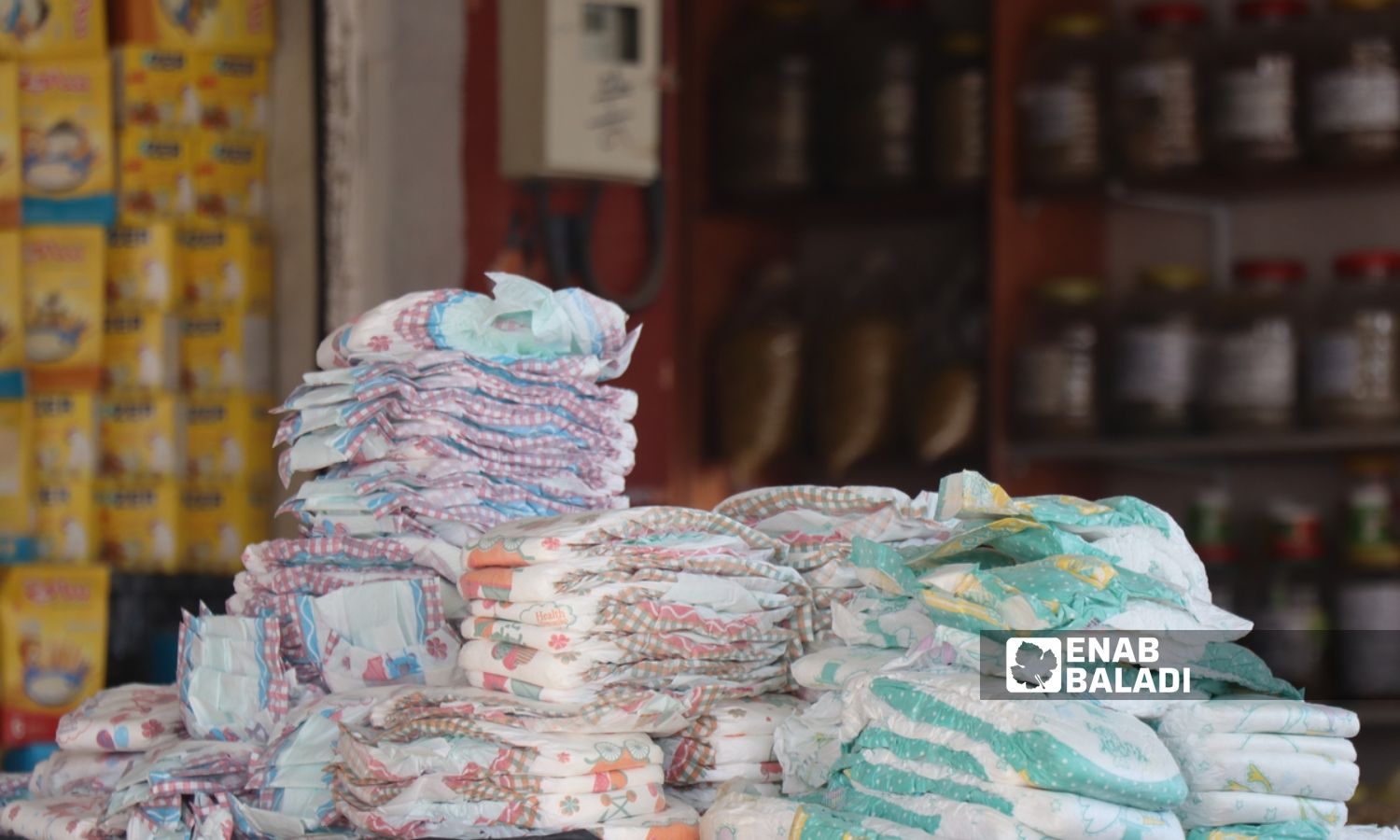



Enab Baladi – Ras al-Ain
Residents of Ras al-Ain, in the northwest of al-Hasakah, are suffering from significant increases in the prices of children’s diapers, which has led some to use cloth pieces as an alternative. This, in turn, has led to the spread of skin diseases among children, including allergies and infections.
Enab Baladi obtained a list of diaper prices in Ras al-Ain, notably the Pampers brand, which comes in wrapped boxes containing 30 high-quality pieces, priced at 75,000 Syrian pounds. The Turkish variety is also packaged in boxes of 30 pieces and costs 65,000 Syrian pounds. The commercial varieties come in boxes of 30 pieces and are priced at 50,000 Syrian pounds.
For unpackaged diapers sold by weight, their qualities range from good at 40,000 Syrian pounds per kilogram to medium quality at 37,000 pounds, and they are of unknown origin and quality.
The population of Ras al-Ain, which amounts to about 115,000 people, face challenging economic difficulties, including challenges in agriculture and marketing crops, along with a lack of job opportunities and low wages. As a result of these challenges, they have been forced to reduce consumption of many basic essentials, including children’s diapers, which are crucial for child health.
Maha Zein al-Din, displaced from Damascus, told Enab Baladi that she did not expect to reach such a difficult financial situation. She explained that she had to halve the amount of diapers used by her child due to rising prices.
She added that she previously used the diaper once, but had to wash, dry, and reuse it, which could possibly cause an allergy and irritation to the child’s skin. She was forced to borrow money from her brother to buy a sufficient amount until her husband finds a job and pays off the debt.
Faisal al-Aziz, a resident of Ras al-Ain, complained about the high diaper prices, which do not match his income. The man relies on agriculture to sustain his family’s livelihood, and a day’s wage does not exceed 40,000 Syrian pounds.
Al-Aziz mentioned that he previously bought two kilograms of diapers weekly for his child, but now he buys about two pieces per day due to the high prices. He explained that the mother uses a layer of cloth inside the diaper to protect it from quick damage and to use it a second time.
For her part, Marwa al-Jassim told Enab Baladi that she has dispensed with the use of ready-made diapers for her son for two years, due to her family’s bad financial circumstances. She explained that she primarily relies on using soft cloth pieces, wrapped in a type of nylon and pieces of dry tissues to preserve them longer.
Al-Jassim, mother of two, finds herself forced to use these traditional tricks due to the large expenses of children’s necessities like milk and diapers. Although her children developed skin allergies initially, they grew accustomed to it later, the mother added.
Like other products and goods, the prices of diapers are affected by the value of the Syrian pound against the US dollar. Ali Hardan, who owns a shop selling baby accessories, explained that diaper prices have risen due to direct imports from Turkey. Additionally, the increased costs of transporting them from the Tal Abyad crossing to Ras al-Ain significantly raised their prices.
Hardan added to Enab Baladi that they only purchase children’s diapers with dollars from Turkey, which are later sold in Syrian pounds. This has made a noticeable difference in prices, especially for the imported diapers, with a decline in purchasing interest noticed as daily sales have dropped from around 250 kilograms to no more than 100 kilograms.
Ras al-Ain and Tal Abyad are adjacent to the Turkish border and controlled by the Syrian National Army (SNA), surrounded by battlefronts with the Syrian Democratic Forces (SDF). The Turkish border serves as their only outlet to the outside world.
Agriculture and livestock rearing are the main professions in Ras al-Ain and the northern and northeastern regions of Syria, forming a primary source of income for many residents.
Daily wages in Ras al-Ain range between 30,000 and 40,000 Syrian pounds (approximately two and a half dollars), varying according to the number of hours worked and the nature of the profession, whether in agriculture or construction.
if you think the article contain wrong information or you have additional details Send Correction